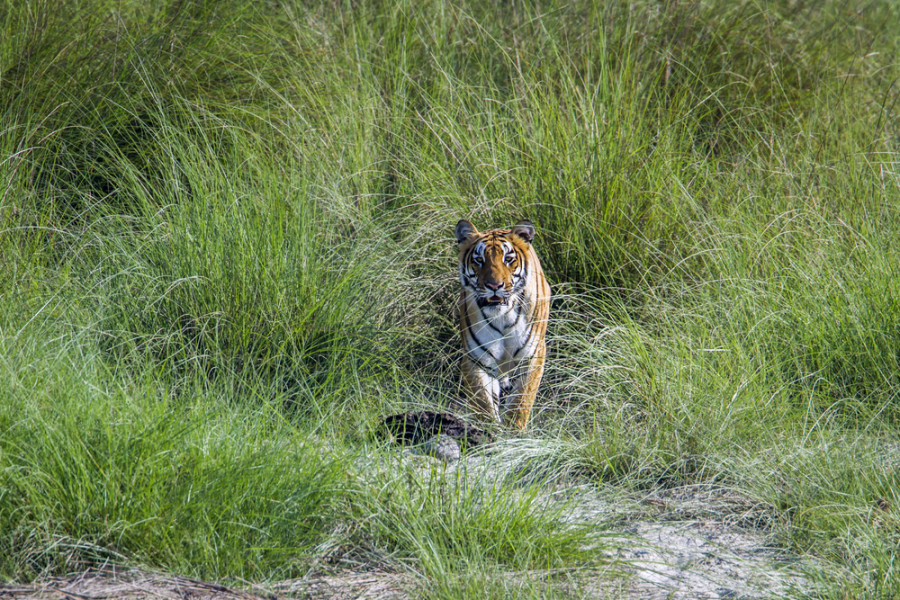Climate & Environment
Tiger numbers are growing and now they are frequently coming out of Bardiya National Park
Territorial clashes among the big cats with an increase in their population is leading to their wandering outside the parks
Chandan Kumar Mandal & Kamal Panthi
Ramkali Shahi and her two friends were attacked by a tiger from Bardiya National Park on Thursday. The trio had gone to a forest adjoining the park to collect fodder for their cattle. Shahi, a resident of Geruwa Municipality-4, was mauled to death by the tiger, while two of her friends managed to flee the scene.
Three days after the incident, another tiger from the same park strayed into a human settlement in Dumreni of Thakurbaba Municipality. The male Royal Bengal tiger fatally attacked Pahariya Tharu, 70, who was feeding pigs in his backyard.
The recent tiger attacks have left people living around Bardiya National Park scared.
“People are scared walking near the forest area,” said Laxman Tharu, a local of Geruwa Municipality. “Since the attack on the women, locals have stopped walking even in the afternoon from the jungle area.”
[Read: This is why leopards are entering our cities]
In light of the recent tiger attacks, the local authority—District Administration Office, Bardiya—has issued a circular advising people to refrain from entering the park’s buffer zone and nearby forest to collect fodder and firewood.
Human-wildlife conflict is not a new incident for the communities living around the park. Bardiya National Park and surrounding areas have always been prone to attacks and property destruction from wild elephants.
But the local authority and the park officials say tigers straying out of their habitats and attacking people is a fairly recent phenomenon. In the last fiscal year, two people were killed in tiger attacks.
Ashok Bhandari, assistant chief conservation officer of the park, attributes the growing incidence of tiger attacks on humans to the rise in tiger population.
When tiger census was conducted last year, keeping Nepal ahead of other countries with big cat species in doubling their population by 2022, Bardiya National Park had recorded impressive growth in tiger numbers, taking the individual tiger count to 87 from 50 in 2013. The result was because of the intensified tiger conservation efforts.
“With the tiger population going up inside the park, the territorial fight among the species, displacing and replacing other tigers and also leading to injuries and death of tigers have increased,” Bhandari told the Post. “After the tiger is displaced or get injured, they end up coming out of the park in search of food.”
The tiger which attacked Tharu on Sunday was also weak, injured and old.
“The tiger had many wounds and had come out for food,” said Bhandari. “It had entered the village for easy prey.”
The national tiger census report, which was released in September last year, has also analysed prey density inside all the protected areas and adjoining forest—which are the potential habitats for tiger species. As per the prey base survey, prey densities, significant for maintaining and boosting the tiger population, marginally declined across all protected areas when compared with the previous census.
The Bardiya National Park also witnessed a decline in prey density from 92.6 to 77.51 animals per square kilometre, according to the survey.
Park official Bhandari, however, denies decline in prey density as the reason behind tigers wandering outside the park.
According to Bhandari, the prey base for tigers improved up to 110 animals per square kilometre in the latest survey conducted by the park. But he admits tigers coming out of the park is a new challenge for tiger conservation.
“The number of tigers has increased. Now, we have to manage their habitat so that they stay inside the park,” said Bhandari. “We have to improve grassland and water sources inside the park which will in return see a rise in prey animals to support the tigers.”
The park has created more ponds inside the park, ensuring that animals do not have to travel more than one kilometre looking for water.
“The tiger is a shy creature. When they don’t get food inside the park, they walk out and during confrontations with humans, they feel threatened and attack,” said Shyam Thapa, conservation officer at National Trust for Nature Conservation (NTNC).
The tiger that attacked Tharu was finally darted and captured on Monday morning. It took a team of 25 people, including the technicians from the park and the NTNC, security personnel and four elephants, to take the tiger under control.
“The maneater has been captured for now. However, people are still fearful. They are hesitant to get out even in a groups of threes and fours.”
***
What do you think?
Dear reader, we’d like to hear from you. We regularly publish letters to the editor on contemporary issues or direct responses to something the Post has recently published. Please send your letters to [email protected] with "Letter to the Editor" in the subject line. Please include your name, location, and a contact address so one of our editors can reach out to you.




 19.12°C Kathmandu
19.12°C Kathmandu












